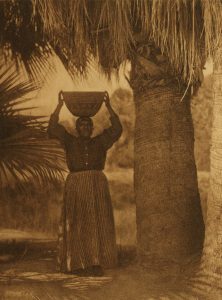 Desai: “… By the time that some of the early founders of Pomona College arrived in Claremont, much of the Tongva population had been decimated by a major smallpox outbreak in 1862, a generation before the College’s founding. After the outbreak, the population of the Tongva in the area fell to around 4,000, a fraction of what it once was. When the founders of the College actually came to Claremont, there was barely a trace of the original people.”
Desai: “… By the time that some of the early founders of Pomona College arrived in Claremont, much of the Tongva population had been decimated by a major smallpox outbreak in 1862, a generation before the College’s founding. After the outbreak, the population of the Tongva in the area fell to around 4,000, a fraction of what it once was. When the founders of the College actually came to Claremont, there was barely a trace of the original people.”
Tidmarsh: “The accounts of interactions between the Pomona students and Native Americans around this time are tantalizingly sparse. In an account of Pomona’s history, Charles Sumner wrote that, in 1913, quote, ‘a party of wild Indians, fittingly mounted, invaded the town soon after daybreak, racing through the streets, brandishing their weapons and giving the war whoop at every turn.’ It would be great to have more context or information or anything about this event, but it’s all that Sumner mentions. We’re left to guess what happened that day.”
Desai: “One of the most enduring legacies of the interaction between early Pomona people and the Native Americans of the area is the song ‘Torchbearers.’ Originally titled ‘Ghost Dance,’ the song was written in 1890, and it’s been performed countless times in a million different versions since then.”
Tidmarsh: “The story goes like this. Frank Brackett, an astronomy professor, went with David Barrows, a student at the time who was interested in the local tribes. They went away off campus to the San Jacinto Mountains, around where the town of Idyllwild is today. This land belonged to the Cahuilla people, who’d lived in that area for thousands of years. Brackett and Barrows ostensibly went up there to observe the native people, and the two wrote down what they could remember of the Cahuilla dance that they’d observed. At a college celebration soon after, they broke into the chant they’d half-remembered, but it was a huge hit. Someone wrote words, and another person a melody. The finished product was titled ‘Ghost Dance,’ and before anyone knew it, Barrows’ and Brackett’s trip up to the mountains was memorialized. And it was apparently quite the sensation among Pomona students at the time. Some archival photos show members of Pomona’s Glee Club performing the song dressed in white robes, dancing around a mock-up of a ritual fire.”
Desai: “Fun fact: Barrows went on to become the first person to receive a Ph.D. in anthropology from the University of Chicago, and eventually he became the president of the University of California system. A lot of his work as an anthropologist had to do with Native Americans. His doctoral dissertation was titled ‘The Ethnobotany of the Cahuilla Indians of Southern California,’ and he conducted his research by returning to Southern California for the summer. So his relationship with the tribes of Southern California wasn’t just some passing craze.”
Tidmarsh: “That being said, though, he and Brackett got a number of facts wrong. For one, they interpreted the Cahuilla dance as warlike, and the lyrics reference ‘Indian maids and warriors.’ But they were just completely off base with this. It wasn’t a war dance at all, like they assumed. An article in the Pomona magazine recounting their trip noted that the shaman who was leading the dance was advocating for racial harmony. It was a peaceful dance. In its original incarnation, the song also included bits of nonsense words that were supposed to approximate the Cahuilla language, but neither Brackett nor Barrows spoke the Cahuilla language at the time, so they did the best they could to transcribe the refrain they heard at the dance. ‘He ne terra toma’ is what they ended up with, but no one’s been able to say for sure what these nonsense syllables were actually supposed to mean. …”
This entire episode is available for download at soundcloud.com, iTunes or Google Play.
